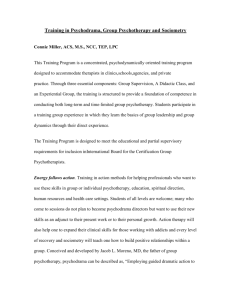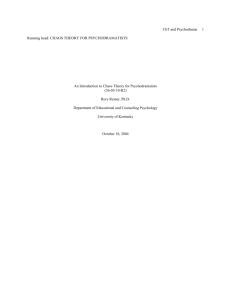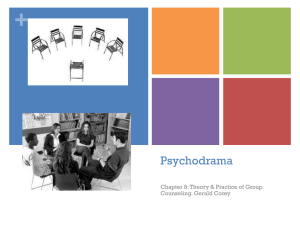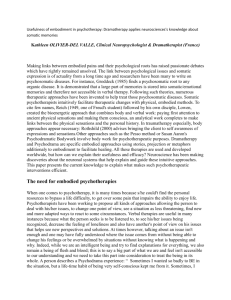Chaos Theory Implications for Psychodramatists
advertisement
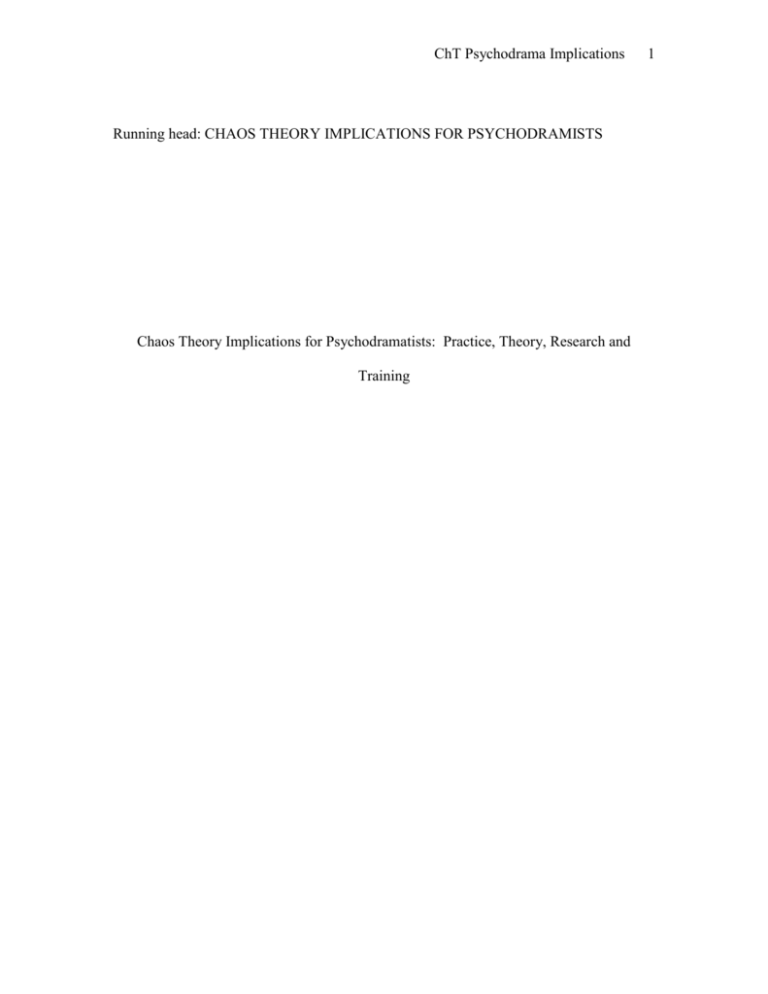
ChT Psychodrama Implications Running head: CHAOS THEORY IMPLICATIONS FOR PSYCHODRAMISTS Chaos Theory Implications for Psychodramatists: Practice, Theory, Research and Training 1 ChT Psychodrama Implications 2 Abstract Individuals and groups are dynamical systems that generate patterns of behaviors, thoughts, feelings, and interactions. Chaos Theory (ChT), based on a mathematical approach to the non-linear, non-independent modeling (rather than the more typical linear modeling approaches used in the social sciences, such as structural modeling), can be used to understand what produces and influences these patterns. ChT has important insights to offer Psychodramatists, and implications for the conduct of the social sciences as a whole. Psychodramatists should have a basic, working knowledge of ChT--its impact and implications, since this representation of reality may be more accurate and lead to different conclusions about how to function. In the previous expositions I gave a mathematical and conceptual overview of ChT and related it to the definition and mission of Morenean Theory (Remer, 2005a, 2006). Using these bases, implications for practice, theory, research, and training are discussed and problems of and suggestions for incorporation of ChT into training Psychodramatists are addressed. ChT Psychodrama Implications 3 Chaos Theory Implications for the Psychodramatists: Practice, Theory, Research and Training Over the last few years a number of articles dealing with Chaos Theory (ChT) and its connections to Morenean conceptualizations have appeared (Remer, 1996, 1998, 2000, 2001a, 2001b, 2002, 2005a, 2006). While they have hopefully been interesting and even intriguing, the main reaction they provoke is “So what’s the big deal? How can something so seemingly esoteric have an impact on the practice of psychodrama for most of us?” A fair enough question, one that deserves some answer. Remer (2005a) provided an introduction to the underpinnings, concepts, terms, and constructs of ChT, relating them to Morenean theory. Remer (2006) followed that effort with a more extensive demonstration of the connections between the two theories, emphasizing the possibilities for cross-fertilization. In this exposition the potential impact and implications of ChT for Morenean thought are addressed on a more global level. If, as purported, ChT informs the actions of Psychodramatists, where does this development lead and what must be done to foster it? Before launching into this discussion, a very brief orientation seems in order, particularly for those not familiar with these articles. I have aimed to conduct the present discourse using terms, concepts, and constructs more generally understandable and applicable (e.g., patterns, unpredictability) than those more specific to ChT (e.g., fractalness, self-affinity) so that a lengthy review will not be necessary. For a far more complete, extensive introduction to ChT, in general, and its relationship to Morenean thought specifically, including definitions and examples of ChT terms and constructs, the reader is referred to the articles already mentioned. In these sources the intricacies of ChT Psychodrama Implications 4 looking at phenomena from a dynamical systems perspective (e.g., the definition of strange attractors) and the workings (e.g., the implications of recursivity or the magnitude of the tuning constant) of specific models, such as the logistic map mentioned next, are discussed in far more detail than is permitted by the limits placed on this exposition. Background: A Brief Refresher1 Although ChT provides many ideas to be considered when applying psychodramatic interventions, perhaps the key one has to do with what it says about change in the patterns generated by dynamical systems--what conditions must be present for change to occur (Remer, 2006). Look at the logistic function--one particular dynamical systems model, among others, developed to explore a particular phenomenon-that generates chaotic patterns, particularly the tuning constant, k. xn+1 = k xn (1-xn) The pattern of plotted data generated from the function indicates that lasting change, the production of a different pattern, occurs only when the sensitivity of the system (as represented by the magnitude of the tuning constant, k) is high enough to promote it. Otherwise, any deviations see the patterns return to their previous state. Thus change can occur only when the system is far from equilibrium. The one essential is that patterns have to be disrupted for them to change. However, the need to influence the sensitivity of the system suggests a flaw (or misnomer) concerning the conceptualization of dynamical systems, at least as indicated by the logistic function. In fact, k, is not a constant but rather a variable that can and must be elevated adequately if change is to occur (and perhaps reduced if patterns are to stabilize). So a more apt characterization might be: ChT Psychodrama Implications 5 xn+1 = kn xn (1-xn) Regardless, the concepts and constructs ChT supplies to discuss patterns and their characteristics are still those presented in the manuscripts mentioned: (a) phase space (b) strange attractors and their basins of attraction, (c) fractals, (d) self-affinity/selfsimilarity, (e) bifurcation and bifurcation cascade, (f) unpredictability, (g) recursivity, (h) resonance, (i) disequilibrium, and (j) self-organization. Implications of ChT for Psychodramatists and Others The implications of ChT for psychodramatists must address both the techniques employed and the context in which they are learned and applied. The former task is too extensive to be addressed here (suggestions will be provided in the discussion of implications for practice where the reader may go to find extant literature dealing with sociometric interventions related to ChT). The latter, however, provides the necessary basis not only for evaluating present interventions’ application and effectiveness, but also for examining our present perspective and practices. Primarily, to promote change the patterns must be disrupted, which can only be accomplished if kn is accommodating. Specifically, energy must be introduced to raise the system’s sensitivity, a singular focus and seemingly simple goal. Interventions are intended to foster this primary goal, to introduce functional pattern components, and to influence the organization of new (spontaneous) patterns. Each aspect of psychodramatic application from the use of action warm-up techniques, such as spectrograms to closure techniques such as group sharing must be examined for the effectiveness of their contributions to dealing with dynamical systems. An example of this type of specific analysis has been provided for doubling by Remer, Guerrero, and Riding-Malon (2007), ChT Psychodrama Implications 6 looking at the technique of doubling and the theory supporting it in its various forms (e.g., supportive, provocative, information seeking) from a ChT perspective to further inform application. Suggestions for the implementation and application of changes indicated by ChT implications fall into three categories, those for practice, those for theory/research, and those for training. They are, of course, not independent of each other. After much thought about how to be most useful to psychodramatists reading this article, it has been organized in what I hope is a user friendly manner. The primary insight--that sufficient energy must be added to the system to disrupt the existing pattern(s) if change is to occur--the one on which everything else hinges, was presented in the background discussion. Implications stemming from this point and other aspects of ChT are presented with those most likely to be of interest to most people first. Others, perhaps more of interest to a limited audience, though important, are offered later in each section. Practice Prime Psychodramatist Implications Perhaps the most important implication for practice comes in how we portray the process in which clients3 find themselves engaged. We should not convey the idea that solutions exist that will prove everywhere effective. Instead we should be conveying the tentativeness of ChT change (Mairlot, 1992). The concept of "influence" must be substituted for that of "control." We should become more process than outcome oriented. We should be stressing flexibility and adaptability to situations. Rather than just focusing on skill development or specific behavior changes alone, we should be helping clients ChT Psychodrama Implications 7 develop the attitude that accepts and even embraces the vagaries and fluctuations of life (Brack, Brack & Zucker, 1995; Butz, 1993). The non-predictability and uncertainty everywhere present should be reframed as an opportunity for novelty and freedom to change (Miller, 1995; Russell, Murphy, & Peacocke, 1995). As in the cases of research/theory and training, we should teach the skill and habit of attending to fluctuations and to generating other perspectives. Multiple client (Group and Family [Butz, Chamberlain, & McCown, 1997; Koopmans, 1998]) therapy should be viewed as the primary mode of intervention, with individual therapy as a useful adjunct—instead of the other way round. True, the impact of changes in the individual’s dynamical patterns will be felt throughout the system, and those smaller effects can trigger larger ones down the line, but employing more group therapy may well be a much more effective way to capitalize on ChT systems’ characteristics (Remer, 1998). Also, individual intervention seems more analogous to or modeled by one-dimensional models, prone to problematic chaotic patterns (e.g., the logistic model manifests production of some patterns not typical of multiple variable models). The group process can both promote bifurcation and chaos (multiple strange attractors and basins of attraction), limit or contain it within the group patterns (a larger basin of attraction), promote self-organization in both members and the group as a whole (systems and sub-systems), and allow all involved to tolerate the chaotic aspects of the process better. The contributions of group members to the patterns present increase the resources—possible pattern components—available, an extremely important consideration given that a component not present cannot become part of the new pattern in some instances2 (e.g., like those where strange attractor patterns are a product of the ChT Psychodrama Implications 8 folding paradigm). As Pascale, Millemann, and Gioja (2000) indicate, “If data are volatile and untrustworthy and poorly understood, tapping the distributed intelligence of the entire system usually generates better solutions than a central authority” (p. 127). Since this description seems to fit psychodramatic practice quite well, groups would be the approach of choice. On one hand, such an approach would be welcomed as more efficient; on the other it would not fit well with the ideas of empirically validated or manualized treatments because neither process nor outcomes are predictable. Even viewing one-to-one therapy (psychodrama au deux) as a “small” group interaction (i.e., the degenerate case, mathematically labeled), the lack of control requires a trust in the self-organization of the systems involved--therapist, client, and dyad. Most important for psychodrama directing is that the focus is not the protagonist but rather what issues the protagonist represents for the group. Without the group involvement providing the opportunity for resonance (Strogatz, 2003) the dynamical aspects on which to capitalize are less than optimal. Goals and outcomes should be readdressed in a process context. Spontaneity training is just such a process (Fine, 1979; Krippner, 1994; Moreno, 1953/1993; Remer, 1996, 1998). It fits the positive, proactive focus of Morenean thought better than such outcomes as anxiety reduction. Concentrating on these and similar foci also counters the impression that seems to have been created that Morenean thought is Psychodrama, and is a problem focused, remedial, reactive enterprise. Also, more importantly, the goal is not to correct a dysfunctional pattern per se, but rather to create a new pattern of the components present—those of the old pattern and those introduced from outside (e.g., from group member-therapists)—a subtle but extremely significant distinction since the ChT Psychodrama Implications 9 latter does not imply control/predictability. The necessity for disrupting present patterns and the accompanying disconcerted feeling must also be conveyed to normalize the experience and prepare the client. I do not want to imply that being process oriented or preventive is less demanding or "safer," and certainly not more predictable than being remedial—after all one generation's remediation can be the next generation's prevention and sensitivity to initial conditions still must be considered. Nor do I wish to suggest that ChT has nothing to offer if remediation is the goal. In fact, ChT conceptualization for addressing such problems (e.g., PTSD (Hudgins, 2001) or Dissociative Identity Disorder (Raaz, CarlsonSabelli & Sabelli (1993), to named but two) fits quite well. Viewing these conditions as signs of systems dealing with chaos, striving to self-organize is consistent with such symptoms as the intrusion-avoidance cycle. Such an approach does not preclude using any of the present interventions, psychodramatic or otherwise, employed to help those so distressed cope. However, ChT as an overall context adds a broader overall perspective to consider when intervening, since it alerts both therapist and client to the sensitivities and vagaries inherent in the change/healing process. Certainly recognizing whether the system is moving forward, is in bifurcation cascade or is in the midst of self-organization has implications for intervening regardless of how well we can anticipate the interventions effect (Butz, Chamberlain, & McCown, 1997). In any case, change is occurring; new meaning (basin of attraction) is developing. Whether what is happening is PTSD or education or diagnosis or therapy, all are attempts in one form or another at coping with chaos. Any kind of standard, prescribed action that does not take the context, and possible attendant risks inherent in the unpredictability (i.e., unexpected and/or ChT Psychodrama Implications 10 unintended aspects) of the patterns generated, into account will be both less than optimally effective and, at best, ill considered if not unethical. Other Implications Trusting clients' senses of themselves and even our own subjective impressions are concomitant requirements. Part of the process must be to educate clients to recognize and to understand the contexts in which they find themselves and the demands of those contexts (i.e., complexity and its ramifications); then clients can be their own authorities on the impact of the changes they are influencing and experiencing. Not that we cannot and should not contribute by helping to identify patterns (e.g., strange attractors and their basins--Remer, 2002) but we must recognize that clients have access to "means of knowing" to which we are and cannot be privy. Also, impressions formed on the basis of less objective input and derived by more analog processes possess validity. Fortunately, this shift, at least in one respect, is more easily achieved on the practice level than those of theory/research and training. Partly these types of inputs are already more generally accepted in practice as we engage in a co-creative endeavor (Worell & Remer, 1992, 2003). The skepticism visited on researchers by the assumption of exclusivity and the need to identify universal laws has never totally been accepted in practice because for many practitioners the therapy process has always been seen as necessarily more idiosyncratic (Biglan & Hayes, 1996; Goldfried & Wolfe, 1996), a point to keep in mind when research implications are discussed. Can clients handle the “complexity” shift? Many, if not most, clients, and the rest of us, seek simplicity in both life and in the change process. While simple explanations may at first seem more understandable, usable, and reassuring, they are not only simple ChT Psychodrama Implications 11 but also simplistic. As such they do not serve us well in the long run and are misleading if not embedded in the larger context of the change process--they do not help us prepare for the need to adapt spontaneously. Teaching clients to accept and even to embrace the possibilities inherent in ChT, instead of panicking when chaos is encountered, is not only a more accurate representation of that with which they must learn to deal, but it is also more freeing and empowering (Stevens, 1991). In fact, at both a practical level and a theoretical one the ability not only to recognize the parameters of a situation, but also to reframe and to redefine them is productive, if not essential (Sandford, 1989; Watzlawick, Weakland, & Fisch, 1974). We can replace, or at least balance, skepticism about or fear of change at both levels with wonder and appreciation of the flexibility and adaptability of human beings--a more positive, Morenean perspective. The primary distinguishing characteristic of human beings is that we strive to make meaning (i.e., we are “symobia,” Butz, 1997). Struggles with this goal seem far more apparent in dealing with the young and the elderly whose life transitions and challenges seem more marked. Perhaps, addressing what makes life worth living--things like fun/play, relationships--as parts of a more functional pattern (strange attractor/basin) would influence clients in a more positive direction. In settings like schools, youth centers, elder-care centers, “old” type campus counseling centers, with tools like art, singing, cooperative games, spontaneity training, we can aid “clients” not only to solve problems and remediate, but to achieve a balanced, more fulfilling existence. By inculcating people to think and to live more “chaotically,” (i.e., occasionally engendering and engaging in disruption of patterns) we may be able to be more preventive--allowing ChT Psychodrama Implications 12 them to be more spontaneous and adaptable, tolerating the discomfort at times necessary to being so. Of course, much of the third party reimbursement structure under which we now operate will not support these efforts. Too, preventive, mental wellness, psychological resilience oriented interventions do not fit well with present demands--too hard to validate empirically, too unpredictable for time-limited intervention. However, the two target groups mentioned, the young and the elderly, are more "government" supported anyway. By "selling" psychodramatic approaches and interventions, we may be able to increase or develop support for these services. If we are successful in those endeavors and they become popular expectations of psychodramatists, we may even create a market in the "middle aged" population for what we have to offer. ChT implies that the whole “mainstream” approach to assessment will have to be re-examined and reoriented. The production and use of standardized, “objective” tests will have to be put in new perspective. At best such instruments, and other static views of individuals, are of limited use in identifying patterns and fluctuations recognized to be dynamical, non-linear, and recursive. They measure at most one point in a phase space from one chosen (and hence subjective/biased) perspective. The concepts of adequate psychometric properties of instruments, particularly reliability, and criteria for judging an instrument’s adequacy will have to be rethought. As they now stand they are both unattainable and, in most cases, undesirable from a ChT point of view, being too context insensitive--an argument already made and problem being addressed by Multicultural Psychologists (e.g., Reid, 1999; Sue & Sue, 1990; Weber, Higginbotham, & Leung, 1999). Diagnoses can at best be seen as identifying a boundary of an existing basin of ChT Psychodrama Implications 13 attraction. More collaborative, inclusive (of clients views), and subjective data, recognizing multiple biases (phase spaces) will perforce need to be employed and incorporated. Procedures focused more on fluid pattern recognition and, in addition, that recognize not only the reality of assessment influencing what is being assessed and even demanding assessment actively be part of the intervention must be employed. Moreno anticipated such needs in his development of role tests, spontaneity tests, sociometry, and social atom portrayals. ChT requires a flexible, integrative approach to practice. Inclusion of and collaboration with clients is essential to include their perspectives and input to appropriate intervention. In addition, and more important, clients must be provided adequate education to be able to understand and flexibly employ the tools--techniques and theoretical “maps”--to which they are introduced and as independent of the therapist as possible. ChT can offer a larger basin of attraction, a meta-structure, for generating such approaches (e.g., Remer, 2000, 2002) already consistent with how psychodramatists practice. Practice Conclusion Advances have already been made in examining specific psychodramatic interventions and applications for the ChT perspective. Over the last few years a number of articles applying the concepts of Chaos Theory (ChT), nonlinear dynamics and bifurcation (catastrophe) theory have been published in the psychodrama, psychology, and psychiatry literature. Carlson-Sabelli, Sabelli, Patel, and Holms (1992) enhanced the sociometric test to include measures of co-existing opposite preferences underlying sociometric choice and introduced the need to use mathematical dynamics for the ChT Psychodrama Implications 14 analysis of sociometric pattern. Raaz, Carlson-Sabelli and Sabelli (1993) suggested that discontinuity or fragmentation of ones life story cause chaos in relationships, and proposed a psychodramatic method for treating patients with dissociative disorders. Sabelli, Carlson-Sabelli, Patel, Levy and Diez-Martin,(1995) illustrate the practical advantages of plotting feelings of attraction and repulsion on a phase plane. CarlsonSabelli, Sabelli, and Hale (1994) named this technique the “Diamond of Opposites” and introduced several more techniques for applying nonlinear dynamics to Sociometry and sociodynamics. Carlson-Sabelli (1998) describes a therapeutic puppet theatre group she developed for children on an inpatient psychiatric unit that promotes creative responses to conflict through modulating energy input to increase the interaction of opposing forces. Carlson-Sabelli, (2001) reviews psychodrama methods that apply nonlinear dynamics to the practice and research of psychodrama and Sociometry. Remer (2000, 2004, 2005b) has used ChT itself as an intervention to normalize the experience of PTSD for both primary and secondary survivors. However, compared to the extensive volume of knowledge related to practice/intervention presented from a linear perspective these efforts have merely scratched the surface. Implications for practice are general at the moment perforce. Many psychodrama practices are already ChT favorable because of the centrality of spontaneity to all aspects and applications (Remer, 2006). However, until the changes suggested in the discussions of the areas of research and training have been developed--the necessary reorientation to comfort with chaos has been implemented--changes in practice will have to be subtler and more modest for the most part (Butz, et al., 1997). Strides have been made (e.g., Carlson-Sabelli, Sabelli, & Hale, 1994; Kiel & Elliott, 1997; Redington & Reidbord, ChT Psychodrama Implications 15 1992; Sabelli, Carlson-Sabelli, Patel, Levy, & Diez-Martin, 1995) but more are forthcoming and required. The Morenean approach, both past and present, has incorporated or even emphasized much of what I have recommended (e.g., Moreno, 1953/1993; Moreno & Moreno, 1975). However, it has encountered great tension in living in and “proving its value” within a reductionistic context. Although employed by psychodrama practitioners extensively, it has found less acceptance in the “scientific” community. Since ChT, with its broader definition and acceptance of “scientific” proof, is more encompassing, a rapprochement between good scientific practice and the needs of individuals--both clients and practitioners--is possible. Theory/Research To be honest, most contemporary psychodramatists, particularly CP’s and trainees, are more practically oriented. They do not generally concern themselves with research and theory development. I believe some of this penchant could be significantly impacted from adopting the ChT perspective, with the primary implications being well within the realm of acceptance. Primary Research/Theory Implications Of great impact for sociometric research, large N research studies, predicated on deriving generalizable results and rules from averaging effects, independence of observations, and linear fit, among other too often untenable assumptions, should give way to more focused, idiographic oriented, recursive, small N studies--much like done by Moreno (1951) and Piaget (Piaget & Inhelder, 1976). Although large N approaches have their place, more information could be produced without the demands of finding large, ChT Psychodrama Implications 16 “representative” samples. A recursive, heuristic approach aimed at studying few participants either over time or circumstances in depth would provide a different, balancing view (e.g., Remer & Finger, 1995). Perhaps more psychodramatists would actually be scientist/practitioners, in the sense of being producers of knowledge, if/when the research process seemed more in line with—even a by-product of—their day-to-day endeavors. In addition, academics would not need huge grants to conduct grant-studies that require those types of expenditures of time, effort, and money to produce publishable results. The cherished concept and goal of "control" should be revamped. I suggest we start to use the term "influence" (e.g., as in "limited influence" studies rather than "controlled" studies). The use of the term “influence” versus “control” is an important distinction. The question is whether control, by definition, implies “total control?” Or whether there can be any other kind—that is, “partial control.” I would argue “control” goes hand in hand with an either/or, “all or nothing” view. “Partial control” is no solution, because it suggests “total control” of part, which implies a closed system (i.e., no outside interference/influence). ChT, as is the case with other systems approaches, implies that this type of situation is impossible in dynamical systems, certainly those involving human beings. Pattern recognition would be the goal instead of hypothesis testing or estimating effect sizes. Classic approaches to statistical decision-making make little sense in the ChT context. What does a statistically significant difference or large effect size mean? In what context? For how long? With fluctuation expected, we would find replication of results—whatever that phrase means exactly--unlikely. Emphasis needs to be away from ChT Psychodrama Implications 17 looking for differences in “kind” and instead look at those of “degree” (Gilbert & Scher, 1999). More Methodologically Advanced Implications Necessary and more challenging still will be the development of research/theoretical tools for advancing ChT (Ford, 1984; Lonie, 1991). At the moment only a few tools are available to support a shift, although gains are burgeoning, as ChT is better understood and creative approaches are invented (Butz, et al., 1997; Greeno, 1998; Hill, Thompson, & Williams, 1997; Remer & Betts, 1998, Sabelli, 2005). The danger is that without an adequate commitment to change the very basis upon which typical research approaches are predicated--logical positivism--development will not be forthcoming and, non-linearly/paradoxically, without their availability the commitment to change will not occur. We will be in the same position as the USA trying to shift to the metric system--stuck in an antiquated pattern we know we should change for something more functional, but one so much ingrained that we cannot seem to let go of it. What has to be done to facilitate the acceptance and inclusion of ChT oriented approaches and tools? Some changes can be made immediately by borrowing already well established tools from areas consonant with ChT but not entirely antithetical to the present approaches being used--those somewhere in between the two (e.g., “application of situativity,” Greeno, 1998; consensual qualitative research, Hill, et al., 1997 and PopeDavis, et al., 2002). Many naturalistic, constructivist, and qualitative approaches, for example, fall in this rubric because they encourage addressing phenomena and their ChT Psychodrama Implications 18 exploration from a more holistic, interactive, and idiographic perspective, distinctions well noted in the Multi-cultural area (e.g., Reid, 1999). The recent work of Hill, et al. (1997) is a good example of a possible qualitative approach--Consensual Qualitative Research. I think it could be further developed to overcome at least two faults (a) not including the research participants completely, as part of the consensus seeking process--a tenet of feminist research and practice already (e.g., Worell & Remer, 1992, 2003) and suggested by others as well (e.g., Moreno, 1951; Patton, 1984; Pope-Davis, et al., 2002; Runkel, 1990), and (b) its aim toward reductionistic goals. The use of a group to bring in differing views and inputs (including quantitative ones), promoting interaction (increasing chaos), then relying on the group process (self-organization to a new strange attractor and more inclusive basin of attraction) may well be the most effective, if not the most efficient, method of "making new meaning" through negotiation for meaning. Such a method can allow, promote, and capitalize on the inclusion of non-empirical, intuitive, holistic (i.e., analog as opposed digital/linear) inputs, just as it does in the therapy process. Also, by reporting as much of the deliberation interaction as possible (e.g., the inputs considered and how they were weighed), instead of simply the outcomes, others can be reassured, included in the interaction, and stimulated and provoked by it, much like a professional forum (e.g., Remer, 2001a). To be fair, this approach can be very time intensive--particularly on research participants, of whom long-term involvement cannot be demanded--but need not be. Methods already exist to employ a ChT research approach (see Figure 1). The Delphi technique (e.g., Helmer & Rescher, 1959; Jenkins, 1996), grounded theory ChT Psychodrama Implications 19 approach (e.g., Creswell, 1998; Locke & Golden-Biddle, 1997), decision-making laboratory (Froehle, 1998), and, of course, Sociometric explorations (Moreno, 1951) can be used and combined to produce conclusions (recognized as interpretations) based on consensual subjectivity while incorporating linear techniques and empirical evidence in the process. Insert Figure 1 Here Remer and Betts (1998) have employed ChT to under gird their attempts to simulate family interactions. Their aim was to produce the phenomena of families on which to "experiment" using more traditional techniques. They employed both quantitative and qualitative measures to judge their outcomes. Their study is an interesting mix of the two approaches. Their "limitation" of not being able to depict family patterns exactly or reliably may be less of a limitation than supposed, since family patterns are quite chaotic--and one not any more possible to addressed than they do. Evaluative and action research paradigms and theories also have a great deal to offer (e.g., Stronach & Torrance, 1995). They tend to encourage looking at situations from a more idiographic than nomothetic stance and recognize that any involvement, even researching situations, changes and influences them. The concept of "formative evaluation" by its recursive nature also helps encourage accepting phenomena more as processes and the "control" of them as both on going—adjusting--and limited. Paying more attention not only to consistencies, but also fluctuations, both drastic and subtle, should be encouraged (e.g., Greeno, 1998). We should teach the skill and ChT Psychodrama Implications 20 habit of attending to multiple perspectives and changes by helping people learn to reverse figure/ground relationships and practice doing so (e.g., “40% of teenagers using drugs live in the inner city”...where do the other 60% live?). This attitude is built into the ChT conceptual base. The Gestalt Psychologists’ trust in the human mind as an analyzing-synthesizing entity should be more respected. The greatest difficulty in producing ChT research relevant to human dynamical systems, by present standards, is the virtual impossibility of collecting enough data points with sufficient accuracy--except when ongoing physiological responses can be monitored--to analyze for "chaotic" patterns (Butz, et al., 1997). Theoretical concepts and their operationalization would benefit from more reliance on right brain processes and less skepticism of subjective appraisal. Research employing more unfettered human judgment and intuition at least deserves more examination--not simply self-report measures, but recursive, self-analysis (e.g., Kagan & Schauble, 1969; Remer, 1990). The outcomes can hardly be less useful and reliable than the results we are obtaining from many continued attempts at more stringent quantification. As already mentioned in regard to practice implications, but perhaps even more relevant here, “(i)f data are volatile and untrustworthy and poorly understood, tapping the distributed intelligence of the entire system usually generates better solutions than a central authority” (Pascale, Millemann, & Gioja., 2000, p. 127). In the same vein, we need to look at our choice of outcome measures. More process oriented ones (e.g, spontaneous action, decision-making) are actually more reflective both of the uncertainty and of the changing reality of the world than are the static ones most often employed (e.g., acceptance of therapist). Perhaps a focus on ChT Psychodrama Implications 21 boundaries that define both the basin of attraction and the state of a system may provide an answer. The flow of information into a system and the ability of that system to use the information for self-organization (strange attractors/basins of attraction) can help us understand the degree of chaos present and the stability of a system--with the caution that even the attempt to assess a system’s status will perforce affect that system. Although I still believe the more important phenomena will never be measurable (e.g., tele), use of concomitant indicators of chaos and impact on chaotic dynamic patterns—such as blood pressure, heart-rate, CAT scans, MRIs or other physiological measures related to feeling and thought patterns—have been used and could be employed again (e.g., Basar, 1990; Zbilut, Webber, Sobotka, & Loeb, 1993; Sabelli, Carlson-Sabelli, Patel, Zbilut, Messer & Walthall, 1995; Boldrini, Placidi, & Marazziti, 1998; van der Kolk, McFarlane, & Weisaeth, 1996). In conjunction with a move toward more "intuitive," less quantifiable variables, a shift needs to be made to look at data and their analyses in a very different way. Dealing with non-linearity and non-independence is difficult or impossible, even when acknowledged and approached usually via using linear tools, transforming to linearity or excluding those aspects from consideration. The application of Fuzzy Logic and Fuzzy Variables--mathematical approaches to quantifying and expressing our sense of the occurrence of phenomena and the accuracy of their measurement in more comprehensible, “lay” language (e.g., Klir & Yuan, 1995; McNeill & Thro, 1994)--better approximate the certainty with which we can quantify our judgments. In addition, the use of Neural Nets and Fuzzy Decision-making methods, both relying on attempting to use and/or approximate the human intuitive process of successively approaching a goal in ChT Psychodrama Implications 22 mind recursively, more closely simulate the way we make decisions under uncertainty than our traditional approaches (e.g., ANOVA). These new tools also have been shown to be more efficient and, in many cases, as or more accurate (Klir & Yuan, 1995). Such a shift will require a major "retooling" at a conceptual, applications, and training levels. Adapting meta-analysis using a Fuzzy Logic approach would permit drawing more understandable conclusions and making directly useful statements than those made in terms of effect sizes (e.g., positive reinforcement is likely to be effective, rather than positive reinforcement evidences a .75σ effect size), which tend to be reinforcing of the ideal of unattainable accuracy and stability, and thus are misleading.4 The change in label is necessary to change the embedded mind set to be both more representative of reality and more realistic to attain. For example, as noted elsewhere (Remer, 2000), studying the use of humor in therapy (Ashworth, 1997), would be much more amenable to a ChT approach. Much as Remer and associates have done to study families and interventions with them (e.g., Betts & Remer, 1993, 1998; Elliott, 1994; Finger, 1994; Remer, 1985; Remer & Betts, 1998), aspects of "chaos" can be built into the design and research approach--through "modeling" (Runkel, 1990) or psychodramatic simulation (Remer & Betts, 1998) as examples--as well as results incorporating both qualitative and quantitative input from external and subjective sources. In the case of measurement, theory and application will have to undergo major revamping. The present attitude and belief about measurement, is self-defeating from a ChT perspective. The problems and arguments already having been delineated in the “practice discussion,” suffice it to say that the proliferation of instrument development in ChT Psychodrama Implications 23 response to the call for more and more reliable measurement (e.g., The Journal of Counseling Psychology) is, for the most part, a huge waste of time and effort. Even if instruments could be produced to meet the criteria demanded, the “accuracy” and applicability of the data they produce would be misleading. Instead of attacking many studies for their inadequate instrumentation, what is produced should be introduced to the “chaotic” mix of information, as representative of various types of influences and fluctuations—unless the measurement approach employed is clearly inappropriate and/or faulty. The goal of studies results being comparable on the basis of the use of the same instrumentation is virtually and practically unattainable. Methods of analysis recognizing the non-linear, non-independent nature of patterns will have to be employed (e.g., Gottman, Swanson, & Murray, 1999), adapted from mathematics devoted to such conditions, or developed. The ANOVA’s, Regressions, Linear Structural Modeling, Factor Analyses, and other similar approaches relying on spurious assumptions about the nature of data will have to be supplanted in dealing with dynamical, chaotic patterns, perhaps with models similar to the logistical map. Linear modeling based on least-squares criteria would be replaced with non-linear modeling and other probability views, such as those grounded in maximum-likelihood, Bayesian bases. Methods of calculating and interpreting fractal dimensions, the degree of complexity evidence by a system, should be brought to bear. Even in the publication of results, more chaotic dynamical interactions could be engendered. As somewhat already suggested by the change in APA Publication Guidelines, more first-person—less objective stance admitting to personal bias—should be encouraged. We research and write because we are interested in the focus, are ChT Psychodrama Implications 24 “moved” by it. Stop training people to act as if they are removed, “objective.” We have a bias or we would not be investing our energies. Allow that energy, passion in. Doing so might help. Not only would the presentations be less dull, but also the energy might be contagious. The risk, or reality, will be in the triggering of the opposite passion, but ChT suggests that result is beneficial from a both/and stance (rather than an either/or one). Format of publications could be changed by adding other perspectives on or interpretations of the results as parts of the article presentations, like is done in the present format in the Counseling Psychologist. More mix would be engendered. Criteria for acceptance of manuscripts would have to be reconsidered. The problems of space allocation and the implications of publishing fewer manuscripts (e.g., for tenure and promotion decisions) would have to be addressed, however. Making information more available on the Internet using “refereed” sites could be implemented. Theory/Research Conclusion In sum, retain and employ the techniques being used in circumstances for which they are appropriate and to add to the mix. They have proved effective, if in a more limited sense than we usually acknowledge. Continue to produce and test these techniques as what they are—possibly effective, useful tools. However, recognize their limits within the broader, ChT context and interpret their results and impacts accordingly. Beware of attempting to generalize too far--no intervention will likely be universally effective across all situations--or of being to narrowly focused--designing an intervention for one specific subgroup and not applicable beyond those boundaries. Doing so does not simply mean being tentative. Quite the contrary, we should be affirmative in defining their limits as specifically as possible and in conveying their uncertainties in the ChT ChT Psychodrama Implications 25 sense (Robertson & Combs, 1995). Just as in the case of Newtonian Mechanics in physics, in many instances what we do at present is “good enough.” Problems calling for cure or remediation (i.e., those correctable by time limited intervention resulting in permanent changed in a focused domain) would be particularly amenable (e.g., phobia reduction). However, be particularly attuned to the limited domain in which they are applicable and the need to extend our efforts to areas needing non-linear and nonreductionistic perspectives, like much of the purview of Morenean approaches. The changes suggested by the ChT perspective may actually encourage a more demonstrable acceptance of the scientist/practitioner model by psychodrama practitioners. In many ways it meets the intuitive sense of therapeutic demands better, in spite of not always offering simple explanations. In particular, acceptance of this perspective may encourage more research efforts and more support for use of Morenean research techniques and approaches, an area of discomfort and contention for many psychodrama adherents, because it suggest a research approach that is consistent with, if not a by-product of, the psychodrama practitioners’ typical process. Training Although training involves attending to both the previous areas, more immediate implications, hence the primary ones, tend to be aimed toward practice. Training implications result from the suggestions made related to both theory/research and practice areas. I seriously doubt that most psychodramatists would want to become as deeply involved in classically defined research efforts that they would want to address the challenge of learning even more advanced methods than are now applied (e.g., non-linear modeling techniques, such as difference equations, Goldberg, 1958). However, more ChT Psychodrama Implications 26 exposure to action research techniques, much like those already suggested in Moreno’s works (e.g., Moreno, 1951) would help to see how much like what they already do some kinds of research and theory development are. These approaches are very well suited to the idiographic, descriptive demands of the ChT situation—the emphasis placed on pattern recognition related to ChT. However, chaos/dynamical systems would have to be assumed and not tested for (just as logical positivist conditions are now assumed). Perhaps the most challenging aspect of such training is whether the mindset induced by years of education and training in reductionistic thinking can be overcome. This challenge will require consideration of how to apply a ChT approach here—the need to significantly sensitize the system and disrupt the present patterns. Primary(Practical) Training Implications In practice, training in dynamical systems perspectives—the concepts and terms—will be required for the implementation of ChT implications. If, as I posited, group interventions are to be preferred because of both their damping and balancing effects on dynamical systems patterns or/and the potential to increase system sensitivity, then more training in the recognition of such interaction patterns and processes in groups will be needed. Fortunately, much of the training is already part and parcel of CP and TEP training, even if not recognized as such. The primary focus should emphasize methods to integrate multiple perspectives and focus on fluctuating patterns. More attention will be needed to process orientation than content. Practitioners, both in group and individual environments, will need training in coping with their own recognition of and reaction to chaotic patterns, probably requiring examination of biases and inclination toward linear, reductionistic thinking and more personal growth, experiential exposure. ChT Psychodrama Implications 27 Ways of introducing clients to the complexity of their patterns that encourage, rather than intimidate, will need to be taught through the use of group action methods and focus on spontaneity. Although training curricula will be challenged to accommodate such demands, psychodramatists already are better prepared theoretically, philosophically, and attitudinally to accept the challenge than many other disciplines (e.g., psychology). For example, our conferences convene to create a confluence of influences--not just psychodramatists but those from other areas, other disciplines, other professions, consumers, and about any perspective are included--making capitalizing on chaotic dynamics possible. Thus, in one way or another, the process will eventuate anyway. How to be optimally inclusive, give voice to all influences, will be a challenge. Essentially what amounts to a bifurcation of the education and training may induce cascade. The resulting chaos and self-organization could result in creative, adaptive responses of the like we have not yet seen—at least that is what ChT suggests. Secondary(?), Long-term Training Implications Suffice it to say reading through all the Research/Theory implications gives the demanding list of what implications could be and/or are in this area (i.e., whatever training would be required to implement those implications, including coursework not even included generally, if at all, in research training programs at the moment). To not be redundant, significant demands for revamping training in research methods and even in examining the philosophical bases for these tools is required for all social scientists not just psychodramatists. As daunting as this area of training is to most psychodramatists at present, a shift would be even more so, if only because the changes incorporate being ChT Psychodrama Implications 28 more extensively trained in present methods as well as those dictated by a ChT perspective—at least before a transition can be made to more accommodating aspects of a ChT approach. Realistically, considering these implications as immediate goals is only a flight of fancy for a rainy afternoon. A Brief Comment on Drawbacks, Problems, and Limitations As I hope I have conveyed, ChT is not without its problems. It is not the easiest approach to grasp, to apply, or to teach. We lose much of our ability to generalize from the ChT perspective and tools—those that exist—but ChT does not view that type of predictability as possible. Therapy research and practice are slower because of having to address complexity. Perhaps the biggest limitation of ChT is that it does not offer the concreteness, or the direction, of our present approach (Logical Positivism), and never will. We are left with the discomfort of wanting such assurances, but that is not the nature of ChT (or if you believe ChT, of the world). Concluding Remarks and Observations Despite shortcomings, the constructs of ChT--phase space, strange attractors and their basins, fractals, self-affinity, bifurcation and bifurcation cascade, unpredictability, resonance, recursivity, disequilibrium, and self-organization—can contribute both insights into human dynamical patterns and the language to express them. Whether these applications turn out only to be analogous—or even metaphorical—remains to be seen. Perhaps, we are closer to more solid empirical footing than it might seem, depending on how stringent are the criteria we choose to adopt and apply. Fortunately, if not ironically, Morenean thought in general and psychodrama techniques in particular are extremely ChT Psychodrama Implications 29 synergistic with ChT—both, it seems are “somewhat on the periphery” of the mainstream social sciences at the moment. While ChT may also have much to say about a paradigm shift, not just for psychodramatists but for the social sciences as a whole, that focus is for another time and another forum (e.g., Remer, 2002). At the moment and in this forum and previous articles (e.g., Remer, 2006), I hope that I have made the case that ChT has important implications for the practice and further development of our discipline. Let me leave you with one more example of applying ChT. The production of this manuscript—the process of review, revision, editing, and publication—is an example of chaotic dynamical patterns at work. Some reviewers liked it, others hated the same things those reviewers loved (e.g., the tone, the informality, the structure). Some wanted it expanded, others wanted those same areas cut, or even eliminated entirely. The ideas of the author, the reviewers, the editors all went into the mix interactively—bifurcation cascade resulted. The final document is the result of the self-organization of those chaotic patterns. It is a strange attractor producing new patterns of thought, feeling, interaction, and, hopefully, behavior—patterns self-affine, fractal, and unpredictable. After reflecting on such experiences, I am reinforced for my belief in embracing chaos. I have been asked what that imprecation means. Embracing chaos: being fascinated with the complexity and patterns of life, at all levels; at times impressed, at times awed, at times overawed. Always intrigued. So much to study…so much to learn…so many challenges. If you are reading these words, I have had my say--a longer one than I originally intended. If I have “caused” some chaos, good. Chaos is my intention--although the effort ChT Psychodrama Implications 30 at producing it may be unnecessary, since we already seem to be in the midst of it. Maybe it will be enough to promote significant reflection…and self-organization. After all, is that not the purpose of a “Professional Forum?” ChT Psychodrama Implications 31 Notes 1 Note: I fully appreciate that much more explanation of terminology and the theory, mathematical and otherwise, and application of dynamical systems is actually needed. As appropriately indicated by the reviewers, showing a picture of bifurcation cascade, explaining the meaning of the x in the formula, the formula itself, and how the logistic model is derived from the phenomenon of the population fluctuations due to the predator/prey relationships are all worthwhile and, likely, necessary for readers to become more comfortable with this topic. However, all those necessities cannot be addressed here. The vast and burgeoning body of knowledge in this realm attests to the impossibility of attaining, or even approaching, such understanding and comfort. I beg the readers’ indulgence in trusting that I have done my best to give enough information to allow the grasp of the main intent of this article. Certainly, feel free, if not encouraged, to delve into, and perhaps immerse yourself in, the other sources suggested and those to which they too will inevitably lead. 2 Note: Although this statement has been tempered, the original was not qualified, saying unequivocally “an extremely important consideration given that a component not present cannot become part of the new pattern.” Given the seeming contradiction (or more aptly, paradox) presented by bifurcation and bifurcation cascade in the logistic model case yielding values of the function and a pattern not previously evidenced, I was asked to explain and support my statement. So I will attempt to do so by looking at three aspects of the comment: (a) implications of being a model, (b) “seeming” contradiction, and (c) presence of a component, or not. ChT Psychodrama Implications 32 I still believe this statement to be true in the “real” world. Models, especially mathematical models, are ideal representations that have heuristic value because they do make us consider aspects of the real world to which have not attended. However, they are only representations, that is “the map is not the territory.” So while aspects of bifurcations arise seemingly from nowhere with the logistic model, bifurcations in the real world, like those on trees, emerge from components/bases already present. I think this observation is true for patterns produced by real dynamical group interactions. Also, ChT is a study in paradox (e.g., strange attractors where points that attract at one time repel at others). It is the acceptance of this paradoxical aspect that not only challenges but energizes, and can be exploited to promote change in patterns, as so effectively done in the “Diamond of Opposites” (Carlson-Sabelli, Sabelli, & Hale, 1994). In the present case, the challenge to the contradiction produced reflection and clarification. Finally, what is meant by “not present” is a matter for philosophical debate. No pattern is ever exactly like another one, even a repetition of the same one, which is the tension between self-affinity and fractalness. Not only is this observation the essential to ChT but is the key to spontaneity as Moreno captures with the “Canon of Creativity.” The conserve--the group pattern--is disrupted and the new one that emerges from the interaction will be both self-affine and fractal to the previous ones, The new pattern/conserve will be influenced by the previous pattern components (perhaps in opposition to a component) and yet produce a new pattern. Are the components of this new pattern already present? ChT Psychodrama Implications 3 33 Note: I use the term “client” because “protagonist” is too limiting. In the spirit of Moreno, all involved-- protagonist, auxiliaries, group members, and director--are both cotherapists and recipients of the therapeutic impacts. 4 Note: From a rather different perspective, Smith and Glass (1977) actually did unwittingly employ a ChT perspective in their seminal meta-analysis research. By including all research studies they found, regardless of the adequacy of the statistical “control” exercised and despite trying to include adequacy as a factor, unsuccessfully, they allowed a degree self-organization of the many, chaotic results of therapy outcome studies. They even argued that the results of their analysis must be strong to overcome the confounding/dilution of “weak” studies. In a sense, they recognized that the pattern induced (the strange attractor of therapy) was evident. Unfortunately, they had no method for including qualitative data, so the self-organization is probably incomplete--although, personally, I believe that data would only have strengthened their conclusions. Ironically, the major “fault” attributed to their efforts--the inclusion of all studies regardless of their having met the stringent requirements for rigor--turns out to be their major positive attribute from a ChT view. ChT Psychodrama Implications 34 References Ashworth, M. T. (1997). The impact of therapist-initiated self-deprecating humor on female clients' perceptions of therapists. Unpublished doctoral dissertation, University of Kentucky, Lexington. Basar, E. (Ed.) (1990). Chaos in brain function. Berlin: Springer-Verlag. Betts, G. R., & Remer, R. (1993). The impact of paradoxical interventions on perceptions of the therapist and ratings of treatment acceptability. Professional Psychology: Research and Practice, 24, 164-170. Betts, G. R., & Remer, R. (1998). Acceptability of paradoxical interventions: A comparison of simulation and strict analogue methodology. Unpublished manuscript, University of Kentucky, Lexington. Biglan, A., & Hayes, S. C. (1996). Should the behavioral sciences become more pragmatic? The case for functional contextualism in research on human behavior. Applied and Preventive Psychology, 5, 47-57. Boldrini, M., Placidi, G. P. A., & Marazziti, D. (1998). Applications of chaos theories to psychiatry: A review and future perspectives. CNS Spectrum, 3,22-29. Brack, C. J., Brack, G., & Zucker, A. (1995). How chaos and complexity theory can help counselors to be more effective. Counseling and Values, 39(3), 200-208. Butz, M. R. (1993). Practical applications from chaos theory to the psychotherapeutic process, a basic consideration of dynamics. Psychological Reports, 73, 543-554. Butz, M. R. (1997). Chaos and complexity: Implications for psychological theory and practice. Washington, DC: Taylor & Francis. ChT Psychodrama Implications 35 Butz, M. R., Chamberlain, L. L., & McCown, W. G. (1997). Strange attractors: Chaos, complexity, and the art of family therapy. New York: John Wiley & Sons. Carlson-Sabelli, L. (1998). Children’s puppet theatre for traumatized Children: A process theory approach. International Journal of Action Methods: Psychodrama, Skill Training, and Role Playing, 51, 91-112. Carlson-Sabelli, L. (2001). The use of psychodrama in nursing. In Joyce J. Fitzpatrick (Ed). The psychiatricmental Health nursing research digest. New York: Springer. Carlson-Sabelli, L., Sabelli, H.C. & Hale, A. (1994). Sociometry and Sociodynamics. In P. Holmes, M. Karp, & M. Watson (Eds.), Psychodrama since Moreno: Innovations in theory and practice (pp. 145-185). London & New York: Tavistock/Routledge. Carlson-Sabelli, L., Sabelli, H.C., Patel, M., & Holms, K. (1992). The union of opposites in Sociometry: An empirical application of process theory. Journal of Group Psychotherapy, Psychodrama and Sociometry, 44, 147-171. Creswell, J. W. (1998). Qualitative inquiry and research design: Choosing among five traditions. Thousand Oaks, CA: Sage Publications, Inc. Elliott, J. E. (1994). Perceptions of realism in high and low structure simulated families. Unpublished doctoral dissertation, University of Kentucky, Lexington. Fine, L. J. (1979). Psychodrama. In R. Corsini (Ed.), Current psychotherapies (pp. 428459). Ithaca, NY: F.E. Peacock. ChT Psychodrama Implications 36 Finger, S. (1994). Manner of disclosure of homosexuality and short-term acceptance by family members: A simulation using undergraduate research participants. Unpublished doctoral dissertation, University of Kentucky, Lexington. Ford, D. H. (1984). Reexamining guiding assumptions: Theoretical and methodological implications. Journal of Counseling Psychology, 31, 461-467. Froehle, T. (1998, April). Workshop: A demonstration of the Indiana decision-making laboratory. Workshop presented at the Division 17 Great Lakes Conference, Bloomington, IN. Gilbert, L. A.., & Scher, M. (1999). Gender and sex in counseling and psychotherapy. Boston: Allyn Bacon. Golberg, S. (1958). Introduction to difference equations: With illustrative examples from economics, psychology, and sociology. New York: Wiley. Goldfried, M. R., & Wolfe, B. E. (1996). Psychotherapy practice and research: Repairing a strained relationship. The American Psychologist, 51, 1007-1016. Gottman, J., Swanson, C., & Murray, J. (1999). The mathematics of marital conflict: Dynamical mathematical modeling of newlywed marital interaction. Journal of Family Psychology, 13, 3-19. Greeno, J. G. (1998). The situativity of knowing, learning, and research. American Psychologist, 53, 5-27. Helmer, O., & Rescher, H. (1959). On the epistemology of inexact sciences. Management Science, 6, 25-52. Hill, C. E., Thompson, B. J., & Williams, E. N. (1997). A guide to conducting consensual qualitative research. The Counseling Psychologist, 4, 517-572. ChT Psychodrama Implications 37 Hudgins, K. (2001). Experiential treatment for PTSD: The therapeutic spiral method. New York: Springer. Jenkins, D. (1996). A reflecting team approach to family therapy: A Delphi study. Journal of Marital and Family Therapy, 22, 219-238. Kagan, N., & Schauble, P. G. (1969). Affect simulation in interpersonal process recall. Journal of Counseling Psychology, 16, 309-313. Kiel, L. D., & Elliott, E. (Eds.). (1997). Chaos theory in the social sciences: Foundations and applications. Ann Arbor, MI: University of Michigan. Klir, G. J., & Yuan, B. (1995). Fuzzy sets and fuzzy logic: Theory and applications. Upper Saddle River, NJ: Prentice Hall P T R. Koopmans, M. (1998). Chaos theory and the problem of change in family systems. Nonlinear Dynamics, Psychology, and Life Sciences, 2, 133-148 Krippner, S. (1994). Humanistic psychology and chaos theory: The third revolution and the third force. Journal of Humanistic Psychology, 34(3), 48-61. Locke, K., & Golden-Biddle, K. (1997). Constructing opportunities for contribution: Structuring intertextual coherence and "problematizing" in organizational studies. Academy of Management Journal, 40, 1023-1062. Lonie, I. (1991). Chaos theory: A new paradigm for psychotherapy? Australian and New Zealand Journal of Psychiatry, 25, 548-560. Mairlot, F. E. (1992). A consideration of all epistemological aspects of human personality: A new research paradigm in psychopathology. Annales-MedicoPsychologiques, 150 (4-5), 256-261. ChT Psychodrama Implications 38 McNeill, F. M., & Thro, E. (1994). Fuzzy logic: A practical approach. Boston, MA: AP Professional. Miller, M. J. (1995). A case for uncertainty in career counseling. Counseling and Values, 39, 162-168. Moreno, J. L. (1951). Sociometry, experimental method and the science of society. Ambler, PA: Beacon House, Inc. Moreno, J. L. (1953/1993). Who shall survive? Foundations of sociometry, group psychotherapy and sociodrama. (Student edition). Roanoke, VA: Royal Publishing Company. Moreno, J.L., & Moreno, Z. T. (1975). Psychodrama (second volume): Foundations of psychotherapy. Beacon, NY: Beacon House. Pascale, R. T., Millemann, M., & Gioja, L. (2000). Surfing the edge of chaos: The laws of nature and the new laws of business. New York: Crown Business. Patton, M. J. (1984). Managing social interaction in counseling: A contribution from philosophy of science. Journal of Counseling Psychology, 31, 442-457. Piaget, J. & Inhelder, B. (1969) The psychology of the child. New York: Basic Books Inc. Pope-Davis, D. B., Toporek, R. L., Ortega-Villalobos, L., Ligiero, D. P., Brittan-Powell, C. S., Liu, W. M., et al. (2000).. Client perspectives of multicultural counseling competence: A qualitative examination. The Counseling Psychologist, 30, 355393. Raaz, N., Carlson-Sabelli, L., & Sabelli, H.C. (1993). Psychodrama in the treatment of ChT Psychodrama Implications 39 multiple personality disorder: A Process-theory perspective. In E. Kluft (Ed.), Expressive and functional therapies in the treatment of Multiple Personality Disorder (pp. 169-188). Springfield, IL: Charles Thomas Redington, D. J., & Reidbord, S. P. (1992). Chaotic dynamics in autonomic nervous system activity during a psychotherapy session. Biological Psychiatry, 31, 9931007. Reid, P. T. (1999). Poor women in psychological research: Shut up and shut out. In L. A Peplau, S. C. Debro, R. C. Veniegas, & P. L. Taylor (Eds.), Gender, culture, and ethnicity: Current research about women and men. (pp. 336-352). Mountain View, CA: Mayfield. Remer, R. (1985). An approach to difficulties caused by evolving family expectations: Social atom theory. Journal of Group Psychotherapy, Psychodrama & Sociometry, 38, 96-106. Remer, R. (1990). Family therapy inside-out. Journal of Group Psychotherapy, Psychodrama and Sociometry, 43, 70-l. Remer, R. (1996). Chaos theory and the canon of creativity. Journal Group Psychotherapy, Psychodrama and Sociometry, 48, 145-155. Remer, R. (1998). Chaos theory and the Hollander psychodrama curve: Trusting the process. International Journal of Action Methods: Psychodrama, Skills Training and Rolelaying, 50, 51-70. Remer, R. (2000). Sociatric interventions with secondary victims of trauma: Producing secondary survivors. In P. F. Kellerman & M. K. Hudgins (Eds.), Psychodrama and trauma: Acting out your pain (pp. 316-341). London: Jessica Kingsley. ChT Psychodrama Implications 40 Remer, R. (2001a). Let's play MORENO. International Journal of Action Methods: Psychodrama, Skill Training, and Role-Playing, 54, 65-73. Remer, R. (2001b). The evolution of sociometric theory from a chaos perspective. International Journal of Action Methods: Psychodrama, Skill Training, and RolePlaying, 53, 17-32. Remer, R. (2002). Blinded by the light. Retrieved August 7, 2007 from http://www.uky.edu/~rremer/Manuscripts.htm/LIGHT.doc/ Remer, R. (2004). When a partner is traumatized: Learning to cope with chaos. In D. R. Catherall (Ed.), The handbook of trauma and the family (pp. 51-68). New York: Brunner-Routledge. Remer, R. (2005a). An introduction to chaos theory for psychodramatists. Journal of Group Psychotherapy, Psychodrama and Sociometry, 58, 130-150. Remer, R. (2005b). Family disruption: Chaos vs. havoc. In V. L. Bengston, A. C. Adcock, K. R. Allen, P. Dilworth-Anderson, & D. M. Klein (Eds.), Sourcebook on family theory and research. (pp. 123-124). Thousand Oaks, CA: Sage. Remer, R. (2006) Chaos theory links to Morenean theory: A synergistic relationship. Journal of Group Psychotherapy, Psychodrama and Sociometry, 59, 55-85. Remer, R. & Betts, G. R. (1998) The difference between strict analogue and interpersonal psychodramatic simulation methodology (IPS) in research on human dynamical systems. International Journal of Action Methods: Psychodrama, Skills Training and Rolelaying, in press. Remer, R., Guerrero, J., & Riding-Malon, R.(2007). Psychodrama from a chaos theory perspective: Reinterpreting Moreno. In C. Baim, J. Burmeister & M. Maciel ChT Psychodrama Implications 41 (Eds.), Psychodrama: Advances in theory and practice. (pp. 97-110). New York: Routledge. Remer, R., & Finger, V. S. (1995). A comparison of the effects of sociometry components on personal and interpersonal growth. Journal of Group Psychotherapy, Psychodrama and Sociometry, 48, 114-117. Robertson, R., & Combs, A. (Eds.), (1995).Chaos theory in psychology and the life sciences. Hillsdale, NJ: Lawrence Erlbaum Associates, Inc. Runkel, P. J. (1990). Casting nets and testing specimens: Two grand methods of psychology. New York, NY: Praeger. Russell, R. J., Murphy, N., & Peacocke, A. (Eds.). (1995). Chaos and complexity: Scientific perspectives on divine action. Vatican City State: Vatican Observatory Publications and The Center for Theology and the Natural Sciences, Berkeley, CA. Sabelli, H. (2005). Bios A study of creation (with CD-Rom Bios Data Analyzer). Hackensack, NJ: World Scientific. Sabelli, H.C., Carlson-Sabelli, L., Patel, M., Levy, A. & Dietz-Martin, M. (1995). Anger, fear depression and crime: Physiological and psychological studies using the process method. In Robertson and Combs. (Eds.), Chaos theory in psychology and the life sciences. (pp. 65-88), Mahwah, New Jersey: Sabelli, Carlson-Sabelli, Patel, Zbilut, Messer, & Walthall (1995). Psychocardiologicl protraitrs: A clinical application of process theory. In (Abraham F.D and Gilgen, A.R., Eds.) Chaos theory in psychology (pp 107-125). Westport, CT: Praeger. Sandford, J. (1989). The fool’s run. New York, NY: Berkley Books. ChT Psychodrama Implications 42 Smith, M. L., & Glass, G. V (1977). Meta-analysis of psychotherapy outcome studies. American Psychologist, 32, 752-760. Stevens, B. A. (1991). Chaos: A challenge to refine systems theory. Australian and New Zealand Journal of Family Therapy, 12, 23-26. Strogatz, S. (2003). Sync: The emerging science of spontaneous order. New York: Hyperion. Stronach, I., & Torrance, H. (1995). The future of evaluation: A retrospective. Cambridge Journal of Education, 25, 283-299. Sue, D. W., & Sue, D. (1990). Counseling the culturally different: theory and practice (Second Edition). New York: John Wiley & Sons. van der Kolk, B. A., McFarlane, A. C., & Weisaeth, L. (Eds.). (1996). Traumatic stress: The effects of overwhelming experience on mind, body, and society. New York: Guilford Press. Watzlawick, P., Weakland, J. H., & Fisch, R. (1974). Change: Principles of problem formation and problem resolution. New York, NY: W. W. Norton & Company. Weber L., Higginbotham, E., & Leung, M. L. A. (1999). Race and class bias in qualitative research on women. In L. A Peplau, S. C. Debro, R. C. Veniegas, & P. L. Taylor (Eds.), Gender, culture, and ethnicity: Current research about women and men. (pp. 353-363). Mountain View, CA: Mayfield. Worell, J., & Remer, P. (1992). Feminist perspectives in therapy: Empowering diverse women. Chichester, England: John Wiley & Sons. Worell, J., & Remer, P. (2003). Feminist perspectives in therapy: An empowerment model for women (2nd ed.). Hoboken, NJ: John Wiley & Sons. ChT Psychodrama Implications 43 Zbilut, J. P., Webber, C. L. Jr., Sobotka, P. A., & Loeb, H. (1993).Recurrence analysis of heart rate variability. Journal of American Cardiology, 21, 439-445. ChT Psychodrama Implications Figure Title and Caption Figure1. Non-linear, inter-subjective research process: Interaction of strange attractors 44

